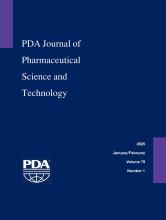Abstract
The dropping of glass vials based on negligence or accidental events that occur during the preparation or mixing of injectable drugs are examples of instances of occupational exposures occurring in a clinical setting. To reduce such risks, several types of glass vial packaging have been developed. We herein compared the resistance of base- and cup-type packaged vials to breakage and scattering of contents during falls with control vials. The falling heights at which test products were dropped were set to 70, 135, and 180 cm. Compared with the control group, appearance changes were inhibited in the cup-type groups. Significant differences were found between the cup-type and control groups at heights of 135 and 180 cm. Next, resistance of packaging to spilling and scattering of solution from the vial was determined. There was no scattering in any types of vials at a height of 70 cm because they were not broken. However, at heights of 135 and 180 cm, the mean scattering distance in the control groups were 50 and 70.6 cm, respectively. At these heights, some vials in the base-type and cup-type group were also cracked, but the solution stayed completely inside the covering packaging, indicating an obvious antiscattering ability. Vials packed in cup- and base-type packaging would lower the risk of the exposure of hazardous drugs during vial breakages. Because the base-type packaging did not show significant antibreakage effects, the cup-type packaging is more suited for hazardous drug packaging. However, cup-type packaging requires equipment investments from pharmaceutical manufacturers. Thus, cost-effectiveness and the target drug profile should be evaluated, and the use of cup- and base-type packaging, as well as control, forms should be selected accordingly.
- Antineoplastic drugs
- Hazardous drugs
- High-alert drugs
- Occupational exposure
- Pharmaceutical packaging
- Vial
- Received August 23, 2020.
- Accepted April 13, 2021.
- Copyright © 2021, Parenteral Drug Association
PDA members receive access to all articles published in the current year and previous volume year. Institutional subscribers received access to all content. Log in below to receive access to this article if you are either of these.
If you are neither or you are a PDA member trying to access an article outside of your membership license, then you must purchase access to this article (below). If you do not have a username or password for JPST, you will be required to create an account prior to purchasing.
Full issue PDFs are for PDA members only.
Note to pda.org users
The PDA and PDA bookstore websites (www.pda.org and www.pda.org/bookstore) are separate websites from the PDA JPST website. When you first join PDA, your initial UserID and Password are sent to HighWirePress to create your PDA JPST account. Subsequent UserrID and Password changes required at the PDA websites will not pass on to PDA JPST and vice versa. If you forget your PDA JPST UserID and/or Password, you can request help to retrieve UserID and reset Password below.






